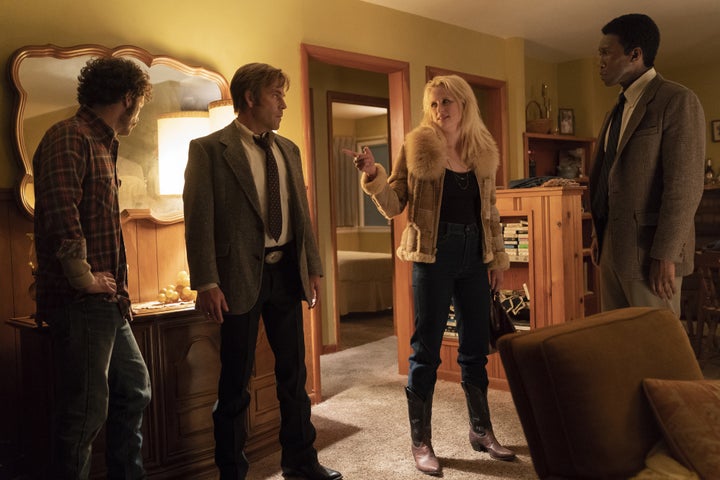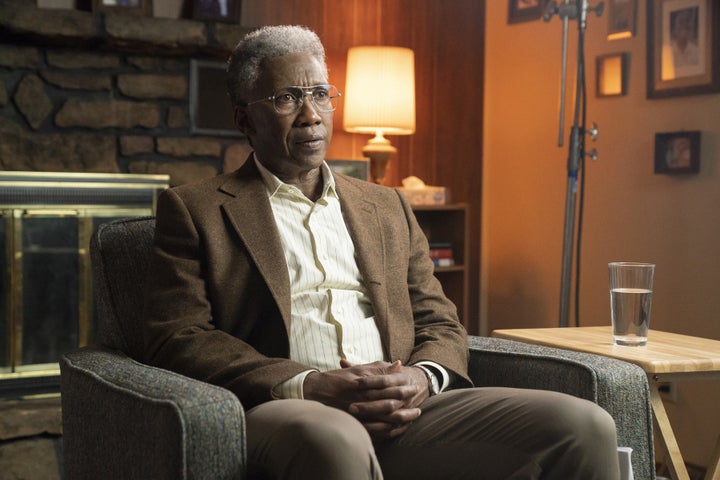
A moody rendition of Son House’s “Death Letter” plays as a handful of vaguely familiar faces flashes across the screen in matte close-up. The haunting headshots are followed by glimpses of various rural locations ― eerie woods, riverbanks and junkyards that will play some sort of role in the crime we’re about to uncover.
Yes, the classic “True Detective” opening credits have returned, hinting that the third installment of Nic Pizzolatto’s HBO series is an attempt to transport fans back to the existential days of Rust Cohle (Matthew McConaughey) and Marty Hart (Woody Harrelson) following a pretty terrible Season 2.
The new edition of the anthology series takes place in the Ozarks, as Vietnam vets and partners Wayne Hays (Mahershala Ali) and Roland West (Stephen Dorff) investigate the disappearance of two young siblings in Arkansas in 1980. Scoot McNairy and Mamie Gummer play Tom and Lucy Purcell, the troubled parents of the children who go missing after taking a late-afternoon bike ride in their quiet town of West Finger. The story flips back and forth between three different time periods ― 1980, 1990 and 2015 ― during which Hays investigates, discovers and relives truths about the Purcell case, all the while experiencing the onset of dementia.

The storyline is certainly reminiscent of Season 1, in which we watched detectives Cohle and Hart get to the bottom of a string of ritualistic murders in 1995 Louisiana. Time was a flat circle when the intense and often metaphorical investigation into Carcosa and The Yellow King was propped up by McConaughey and Harrelson’s undeniable buddy-cop chemistry.
Season 3 brings back the two-man case study, but lacks the groundbreaking feel of the original. We live in an era of TV dominated by grisly detective dramas ― “Broadchurch,” “The Fall,” “Top of the Lake,” Happy Valley,” “Dark,” “Mindhunter” ― making it harder for even an anthology series to stand out. And from the masses has emerged a curiously popular microgenre that’s gripped Pizzolatto too: the Bootheel-border states crime story, epitomized by Netflix’s “Ozark” and HBO’s recent limited series “Sharp Objects” (both set in Missouri).
“True Detective” sets up a compelling enough story in its debut episode, “The Great War and Modern Memory,” weaving between time periods a little better than, say, “Westworld.” Ali, fresh off his Golden Globe win for “Green Book,” rises above the cast of characters, all of whom receive a standard introduction arc in the first half-hour of the show. Wayne “Purple” Hays’ stoic, uneasy demeanor draws you in while you watch him simultaneously fixate on the Purcell case and grapple with his own loss of memory. He mirrors Rust Cohle in that he’s a mysterious loner opting to slug down a few beers rather than commit to a relationship with anyone other than his law enforcement partner. That mentality changes by the ’90s, but family still seems to be a sore spot for an aging Hays as he attempts to remember his detective work for a true-crime documentarian in 2015.
(Disclaimer: The old-man makeup they use to age Ali into the future is distracting. The facial prosthetics covering his usually chiseled face are no better than the ones NBC uses to morph Mandy Moore into a 70-year-old woman on a much schmaltzier “This Is Us.”)

The show hits a lot of high notes while riding on Ali’s shoulders. Car-ride banter is back, this time between Ali and Dorff, who, after a stint on “Star,” gets to play around with the heaviness of a character written for prestige TV. Writer and creator Pizzolatto eagerly jumps into his character development, giving depth to the people forced to investigate and live through a crime, as much as to the crime itself.
But compared to Season 1, the plot feels purposefully less complex, edited to make sure viewers can follow the timeline-spanning saga more easily than they could the freshman version. Pizzolatto eases us into the missing persons case using flashbacks and retelling. In an early scene, Tom Purcell’s kids, Will and Julie, ask their father if they can meet up with a friend. Tom ― dressed in flannel and a baseball cap, dutifully working on his car engine in front of their ranch-style home in a haystack-filled landscape ― demands they be back by 5:30 p.m., “before the sun goes down.”
“Yes, sir,” they answer, politely, as they ride off on their bikes. Tom sips a beer and peers out onto the road, now deserted except for a few parked cars. Enough time passes for the viewer to understand: His kids aren’t coming back.
“I did try to do this thing this year, and I hope we were successful, where I wanted to be like, ‘No tricks up my sleeve.’ Because 2015 and 1990 are happening at the same time as 1980, you’re sort of constantly being told what is going to happen, like all the time,” Pizzolatto told CinemaBlend. “Depending on the viewers’ experience or what they’re trying to do, there is a way you can watch the show, and it’s telling you everything that’s going to happen before it happens. And I wanted to be able to do that to not play any cheap games with the viewer ― to respect their attention and their time ― but still reward them with revelation and reversal.”
Long gone are the days of the McConaissance, but with an Oscar winner on board, “True Detective” is replanting its roots. Maybe the missing persons case feels lackluster when compared to the string of other crime-driven series plucked from the bowels of a dark Ozarkian underbelly. Then again, in the morass of streaming, network and cable options, does a show have to be memorable to be good?
“True Detective,” Season 3, is set to premiere on HBO on Sunday, Jan. 13, at 9 p.m. Eastern.
CORRECTION: A previous version of this article credited the wrong song as the show’s theme. The opening credits of “True Detective” Season 3 feature a Cassandra Wilson rendition of Son House’s “Death Letter.”
